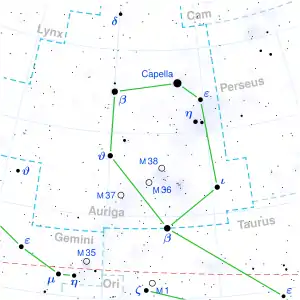Psi1 Aurigae
Psi1 Aurigae (ψ1 Aur, ψ1 Aurigae) is a star in the northern constellation of Auriga. It is faintly visible to the naked eye with an apparent visual magnitude of 4.91.[2] Based upon a measured annual parallax shift of 0.59 mas,[1] it is approximately 5,500 light-years (1,700 parsecs) distant from the Earth. It is receding from the Sun with a radial velocity of +4.7 km/s.[5]
 | |
| Observation data Epoch J2000 Equinox J2000 | |
|---|---|
| Constellation | Auriga |
| Right ascension | 06h 24m 53.90250s[1] |
| Declination | +49° 17′ 16.4127″[1] |
| Apparent magnitude (V) | 4.91[2] |
| Characteristics | |
| Spectral type | K5-M1Iab-Ib[3] |
| U−B color index | +2.29[2] |
| B−V color index | +1.97[2] |
| R−I color index | 1.07 |
| Variable type | LC[4] |
| Astrometry | |
| Radial velocity (Rv) | +4.7[5] km/s |
| Proper motion (μ) | RA: –0.66[6] mas/yr Dec.: –1.82[6] mas/yr |
| Parallax (π) | 0.5867 ± 0.2235 mas[1] |
| Distance | approx. 6,000 ly (approx. 1,700 pc) |
| Absolute magnitude (MV) | −5.53[7] |
| Details | |
| Mass | 14.4 ± 0.8[8] M☉ |
| Radius | 597[lower-alpha 1] R☉ |
| Luminosity | 63,579[9] L☉ |
| Temperature | 3,750[10] K |
| Metallicity [Fe/H] | +0.08[11] dex |
| Age | 12.3 ± 0.4[8] Myr |
| Other designations | |
| Database references | |
| SIMBAD | data |
This is a massive supergiant star with a stellar classification of K5-M1Iab-Ib.[3] It is a slow irregular variable of the LC type, with its brightness varying in magnitude by 0.44.[4] The star is more than 14[8] times as massive as the Sun and is blazing with 63,579[9] times the Sun's luminosity. This energy is being radiated into outer space from its outer atmosphere at an effective temperature of 3,750 K,[10] giving it the orange-red hue of a cool M-type star.
See also
References
- Brown, A. G. A.; et al. (Gaia collaboration) (August 2018). "Gaia Data Release 2: Summary of the contents and survey properties". Astronomy & Astrophysics. 616. A1. arXiv:1804.09365. Bibcode:2018A&A...616A...1G. doi:10.1051/0004-6361/201833051. Gaia DR2 record for this source at VizieR.
- Nicolet, B. (1978), "Photoelectric photometric Catalogue of homogeneous measurements in the UBV System", Astronomy and Astrophysics Supplement Series, 34: 1–49, Bibcode:1978A&AS...34....1N.
- Keenan, Philip C.; McNeil, Raymond C. (1989). "The Perkins Catalog of Revised MK Types for the Cooler Stars". The Astrophysical Journal Supplement Series. 71: 245. Bibcode:1989ApJS...71..245K. doi:10.1086/191373.
- Adelman, Saul J. (2001), "Stars with the Largest Hipparcos Photometric Amplitudes", Baltic Astronomy, 10: 589–593, Bibcode:2001BaltA..10..589A.
- Wielen, R.; et al. (1999), "Sixth Catalogue of Fundamental Stars (FK6). Part I. Basic fundamental stars with direct solutions", Veroeffentlichungen des Astronomischen Rechen-Instituts Heidelberg, Astronomisches Rechen-Institut Heidelberg, 35 (35): 1, Bibcode:1999VeARI..35....1W.
- van Leeuwen, Floor (November 2007), "Validation of the new Hipparcos reduction", Astronomy and Astrophysics, 474 (2): 653–664, arXiv:0708.1752v1, Bibcode:2007A&A...474..653V, doi:10.1051/0004-6361:20078357, S2CID 18759600. Note: see VizieR catalogue I/311.
- Schiavon, Ricardo P. (July 2007), "Population Synthesis in the Blue. IV. Accurate Model Predictions for Lick Indices and UBV Colors in Single Stellar Populations", The Astrophysical Journal Supplement Series, 171 (1): 146–205, arXiv:astro-ph/0611464, Bibcode:2007ApJS..171..146S, doi:10.1086/511753, S2CID 13946698.
- Tetzlaff, N.; Neuhäuser, R.; Hohle, M. M. (January 2011), "A catalogue of young runaway Hipparcos stars within 3 kpc from the Sun", Monthly Notices of the Royal Astronomical Society, 410 (1): 190–200, arXiv:1007.4883, Bibcode:2011MNRAS.410..190T, doi:10.1111/j.1365-2966.2010.17434.x, S2CID 118629873.
- Hohle, M. M.; Neuhäuser, R.; Schutz, B. F. (April 2010), "Masses and luminosities of O- and B-type stars and red supergiants", Astronomische Nachrichten, 331 (4): 349, arXiv:1003.2335, Bibcode:2010AN....331..349H, doi:10.1002/asna.200911355, S2CID 111387483.
- Levesque, Emily M.; et al. (August 2005), "The Effective Temperature Scale of Galactic Red Supergiants: Cool, but Not As Cool As We Thought", The Astrophysical Journal, 628 (2): 973–985, arXiv:astro-ph/0504337, Bibcode:2005ApJ...628..973L, doi:10.1086/430901, S2CID 15109583.
- Bakos, Gustav A. (October 1971), "Abundances of Heavy Elements in Late-Type Stars", Journal of the Royal Astronomical Society of Canada, 65: 222, Bibcode:1971JRASC..65..222B.
- "psi01 Aur". SIMBAD. Centre de données astronomiques de Strasbourg. Retrieved 2012-08-23.
Notes
- Applying the Stefan-Boltzmann Law with a nominal solar effective temperature of 5,772 K: